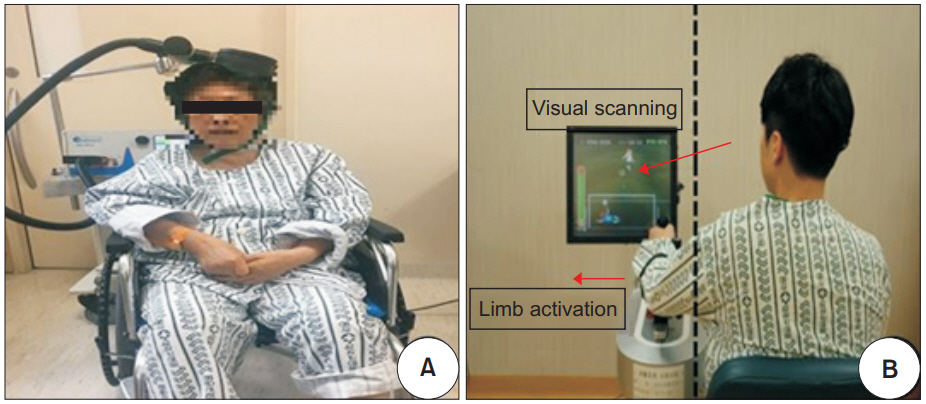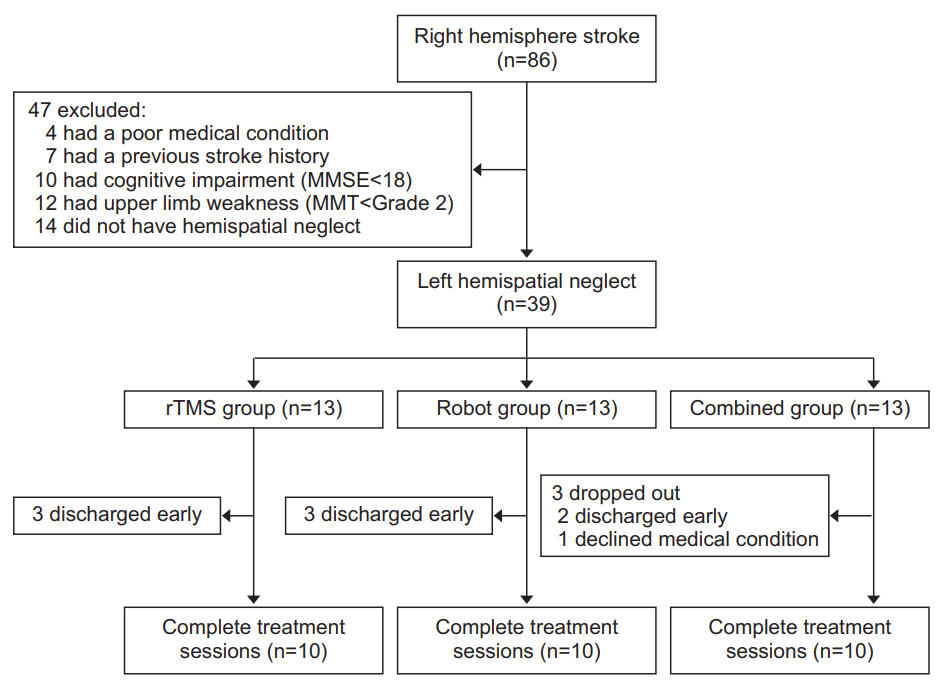Ann Rehabil Med.
2018 Dec;42(6):788-797. 10.5535/arm.2018.42.6.788.
Effect of Combined Therapy of Robot and Low-Frequency Repetitive Transcranial Magnetic Stimulation on Hemispatial Neglect in Stroke Patients
- Affiliations
-
- 1Department of Physical Medicine and Rehabilitation, Dong-A University College of Medicine, Busan, Korea. yoosin201@naver.com
- 2Regional Cardiocerebrovascular Center, Dong-A University Medical Center, Busan, Korea.
- KMID: 2448899
- DOI: http://doi.org/10.5535/arm.2018.42.6.788
Abstract
OBJECTIVE
To investigate the effect of upper limb rehabilitation combining robot with low-frequency repetitive transcranial magnetic stimulation (rTMS) on unilateral spatial neglect in stroke patients.
METHODS
Patients who had hemispatial neglect after right hemisphere stroke were randomly divided into rTMS only group, robot only group, and combined group. All groups received conventional neglect therapy and additional treatment for each group. rTMS group received rTMS therapy. Robot group received robot therapy, while combined group received both therapies. The effect of therapy was assessed with Motor-Free Visual Perception Test-3 (MVPT-3), line bisection test, star cancellation test, Catherine Bergego Scale (CBS), Mini-Mental State Examination (MMSE), and the Korean version of Modified Barthel Index (K-MBI). These measurements were evaluated before and after treatment.
RESULTS
For each group, 10 patients were recruited. There were no significant differences in baseline characteristics or initial values among the three groups. Two weeks after the therapy, all groups showed significant improvement in MVPT-3, line bisection test, star cancellation test, CBS, MMSE, and K-MBI. However, changes in measurements showed no significant differences among groups.
CONCLUSION
Treatment effect of the combined therapy of robotic therapy and low-frequency rTMS therapy for hemispatial neglect was not statistically different from that of each single treatment.
RESULTS
of this study did not prove the superiority of any of the three treatments. Further study with large number of patients is needed to evaluate the superiority of these treatments.
MeSH Terms
Figure
Reference
-
1. Luaute J, Halligan P, Rode G, Rossetti Y, Boisson D. Visuo-spatial neglect: a systematic review of current interventions and their effectiveness. Neurosci Biobehav Rev. 2006; 30:961–82.
Article2. Pierce SR, Buxbaum LJ. Treatments of unilateral neglect: a review. Arch Phys Med Rehabil. 2002; 83:256–68.
Article3. Heilman KM, Valenstein E. Frontal lobe neglect in man. Neurology. 1972; 22:660–4.
Article4. Watson RT, Heilman KM. Thalamic neglect. Neurology. 1979; 29:690–4.
Article5. Damasio AR, Damasio H, Chui HC. Neglect following damage to the frontal lobe or basal ganglia. Neuropsychologia. 1980; 18:123–32.6. Kerkhoff G. Spatial hemineglect in humans. Prog Neurobiol. 2001; 63:1–27.
Article7. Paolucci S, Antonucci G, Guariglia C, Magnotti L, Pizzamiglio L, Zoccolotti P. Facilitatory effect of neglect rehabilitation on the recovery of left hemiplegic stroke patients: a cross-over study. J Neurol. 1996; 243:308–14.
Article8. Paolucci S, Traballesi M, Gialloreti LE, Pratesi L, Lubich S, Antonucci G, et al. Changes in functional outcome in inpatient stroke rehabilitation resulting from new health policy regulations in Italy. Eur J Neurol. 1998; 5:17–22.
Article9. Rode G, Tiliket C, Boisson D. Predominance of postural imbalance in left hemiparetic patients. Scand J Rehabil Med. 1997; 29:11–6.10. Weinberg J, Diller L, Gordon WA, Gerstman LJ, Lieberman A, Lakin P, et al. Visual scanning training effect on reading-related tasks in acquired right brain damage. Arch Phys Med Rehabil. 1977; 58:479–86.11. Antonucci G, Guariglia C, Judica A, Magnotti L, Paolucci S, Pizzamiglio L, et al. Effectiveness of neglect rehabilitation in a randomized group study. J Clin Exp Neuropsychol. 1995; 17:383–9.
Article12. Robertson IH, North N. Spatio-motor cueing in unilateral left neglect: the role of hemispace, hand and motor activation. Neuropsychologia. 1992; 30:553–63.
Article13. Rossetti Y, Rode G, Pisella L, Farne A, Li L, Boisson D, et al. Prism adaptation to a rightward optical deviation rehabilitates left hemispatial neglect. Nature. 1998; 395:166–9.
Article14. Frassinetti F, Angeli V, Meneghello F, Avanzi S, Ladavas E. Long-lasting amelioration of visuospatial neglect by prism adaptation. Brain. 2002; 125(Pt 3):608–23.
Article15. Lo AC. Clinical designs of recent robot rehabilitation trials. Am J Phys Med Rehabil. 2012; 91(11 Suppl 3):S204–16.
Article16. Varalta V, Picelli A, Fonte C, Montemezzi G, La Marchina E, Smania N. Effects of contralesional robot-assisted hand training in patients with unilateral spatial neglect following stroke: a case series study. J Neuroeng Rehabil. 2014; 11:160.
Article17. Choi YS, Lee KW, Lee JH, Kim SB, Park GT, Lee SJ. The effect of an upper limb rehabilitation robot on hemispatial neglect in stroke patients. Ann Rehabil Med. 2016; 40:611–9.
Article18. Kim BR, Chun MH, Kim DY, Lee SJ. Effect of high- and low-frequency repetitive transcranial magnetic stimulation on visuospatial neglect in patients with acute stroke: a double-blind, sham-controlled trial. Arch Phys Med Rehabil. 2013; 94:803–7.
Article19. Yang NY, Fong KN, Li-Tsang CW, Zhou D. Effects of repetitive transcranial magnetic stimulation combined with sensory cueing on unilateral neglect in subacute patients with right hemispheric stroke: a randomized controlled study. Clin Rehabil. 2017; 31:1154–63.
Article20. Kerkhoff G, Bucher L, Brasse M, Leonhart E, Holzgraefe M, Volzke V, et al. Smooth pursuit “bedside” training reduces disability and unawareness during the activities of daily living in neglect: a randomized controlled trial. Neurorehabil Neural Repair. 2014; 28:554–63.21. Shindo K, Sugiyama K, Huabao L, Nishijima K, Kondo T, Izumi S. Long-term effect of low-frequency repetitive transcranial magnetic stimulation over the unaffected posterior parietal cortex in patients with unilateral spatial neglect. J Rehabil Med. 2006; 38:65–7.22. Park JW, Kim SB, Lee KW, Lee JH, Park JG, Lee SJ. Effects of hand training during the aftereffect period of low-frequency rTMS in subacute stroke patients. Ann Rehabil Med. 2018; 42:521–7.
Article23. Mercier L, Desrosiers J, Hebert R, Rochette A, Dubois MF. Normative data for the motor-free visual perception test-vertical. Phys Occup Ther Geriatr. 2001; 19:39–50.
Article24. Schenkenberg T, Bradford DC, Ajax ET. Line bisection and unilateral visual neglect in patients with neurologic impairment. Neurology. 1980; 30:509–17.
Article25. Agrell BM, Dehlin OI, Dahlgren CJ. Neglect in elderly stroke patients: a comparison of five tests. Psychiatry Clin Neurosci. 1997; 51:295–300.
Article26. Albert ML. A simple test of visual neglect. Neurology. 1973; 23:658–64.
Article27. Chen P, Hreha K, Fortis P, Goedert KM, Barrett AM. Functional assessment of spatial neglect: a review of the Catherine Bergego scale and an introduction of the Kessler foundation neglect assessment process. Top Stroke Rehabil. 2012; 19:423–35.
Article28. Salazar APS, Vaz PG, Marchese RR, Stein C, Pinto C, Pagnussat AS. noninvasive brain stimulation improves hemispatial neglect after stroke: a systematic review and meta-analysis. Arch Phys Med Rehabil. 2018; 99:355–366. e1.
Article29. Dai CY, Liu WM, Chen SW, Yang CA, Tung YC, Chou LW, et al. Anosognosia, neglect and quality of life of right hemisphere stroke survivors. Eur J Neurol. 2014; 21:797–801.
Article30. Semrau JA, Wang JC, Herter TM, Scott SH, Dukelow SP. Relationship between visuospatial neglect and kinesthetic deficits after stroke. Neurorehabil Neural Repair. 2015; 29:318–28.
Article31. Masiero S, Carraro E, Ferraro C, Gallina P, Rossi A, Rosati G. Upper limb rehabilitation robotics after stroke: a perspective from the University of Padua, Italy. J Rehabil Med. 2009; 41:981–5.
Article32. Yang W, Liu TT, Song XB, Zhang Y, Li ZH, Cui ZH, et al. Comparison of different stimulation parameters of repetitive transcranial magnetic stimulation for unilateral spatial neglect in stroke patients. J Neurol Sci. 2015; 359:219–25.
Article33. Zhang RG, Liu SX, Wang FY, Ma XC, Yang YH. Treatment of unilateral neglect using repetitive transcranial magnetic stimulation (rTMS) and sensory cueing (SC) in stroke patients. Sichuan Da Xue Xue Bao Yi Xue Ban. 2017; 48:309–13.34. Johnson NN, Carey J, Edelman BJ, Doud A, Grande A, Lakshminarayan K, et al. Combined rTMS and virtual reality brain-computer interface training for motor recovery after stroke. J Neural Eng. 2018; 15:016009.
Article
- Full Text Links
- Actions
-
Cited
- CITED
-
- Close
- Share
- Similar articles
-
- Comparison of Effects of Repetitive Transcranial Magnetic Stimulation with High- or Low-frequency on Visuospatial Neglect in Stroke Patients
- Therapeutic Effects of Caloric Stimulation and Optokinetic Stimulation on Hemispatial Neglect
- Application of Non-invasive Brain Stimulation on Dysphagia after Stroke
- The Effect of an Upper Limb Rehabilitation Robot on Hemispatial Neglect in Stroke Patients
- Effects of Hand Training During the Aftereffect Period of Low-Frequency rTMS in Subacute Stroke Patients




